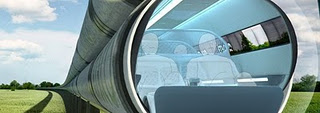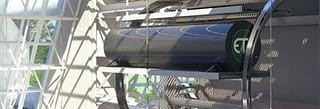Speed and Efficiency: Evacuated Tube Transport
Vehicular roadway and rail traffic move the most people and products, but are unsustainable in the long term due to their inefficiency and negative impact on the environment. Evacuated tube transport reduces energy usage, CO2 emissions, pollution and cost. The magnetically levitated capsules can operate at 1/50 of the energy usage of electric cars and high-speed trains. The overall cost can be just 1/10 of rail development and ¼ of a new freeway project.
The tube transport system, using a tube 1.5m in diameter, can move 94% of all cargo and passengers at high speeds. The trip between Sydney and Melbourne, Australia would take about 23 minutes at an estimated cruising speed of 2600 km/h. Because of the high speed and efficiency, the cost per kilometer is greatly reduce over traditional transportation. As the distance is increased, the energy cost reduces further.
The system, unlike railways, would not schedule runs but instead be demand driven 24 hours per day. Traffic will commence only when the route is set and arrival time is calculated in order to avoid conflicts. Ticket price is based on a fixed charge, distance traveled, time of day, passenger and luggage weight and energy usage. People, of course, would cost more to transport due to life support requirements. Moving cargo would be very cost effective due to its lower priority.
Transportation costs currently use more than 61% of all the oil used by every industry each year. Rising fuel prices will not affect this evacuated tube transportation method. With no drag or friction resistance, most acceleration energy can be recovered during deceleration at the end of a journey. This system has a low environmental impact, is not disruptive to wildlife and have a very small footprint when it comes to land use.
A system servicing the eastern coast regions of Australia with an approximate length of over 1,748 km can transport 150,000 passengers every day and 3.5 billion tons km of cargo every year would cost around $12 billion plus the cost of the land.
Before this technology can be used to create a world-wide efficient transportation, it should be demonstrated. The Sydney to Newcastle link offers 120 km where the evacuated tube transport system can be tested up to 3000 km/h speeds.
View all the Javascript calculations on the web page by right clicking anywhere and selecting “View Source.” Anyone is welcome to conduct their independent calculations before viewing our data or to check the calculations. Feel free to contact Philip Wong at ioserver@ioserver.com with any corrections, comments or critique of this proposal.



ET3 Cost Benefit Risk
|
|
Capital cost, financial and operational performance of ET3 networks
Calculates the cost and performance of a ET3 network given the average distance traveled, length of the network, the expected number of passenger trips per workday and cargo capacity.
Energy Consumption of various modes of transportation
Links
Tube Freight Transportation. U.S. Department of Transport, Federal Highway Administration
Key vacuum technology issues to be solved in evacuated tube transportation
United States Patent No. 5,950,543 Evacuated Tube Transport
Feasibility and Economic Aspects of Vactrains
Australia High Speed Rail Phase 1 Report
Evacuated Tube Transport Technologies: "Space Travel On Earth"
Toward green mobility: the evolution of transport 1998
Large scale energy storage/transmission and freight transportation system
|
Last updated: Thu, 16 Jun 2022 08:02:03 GMT |